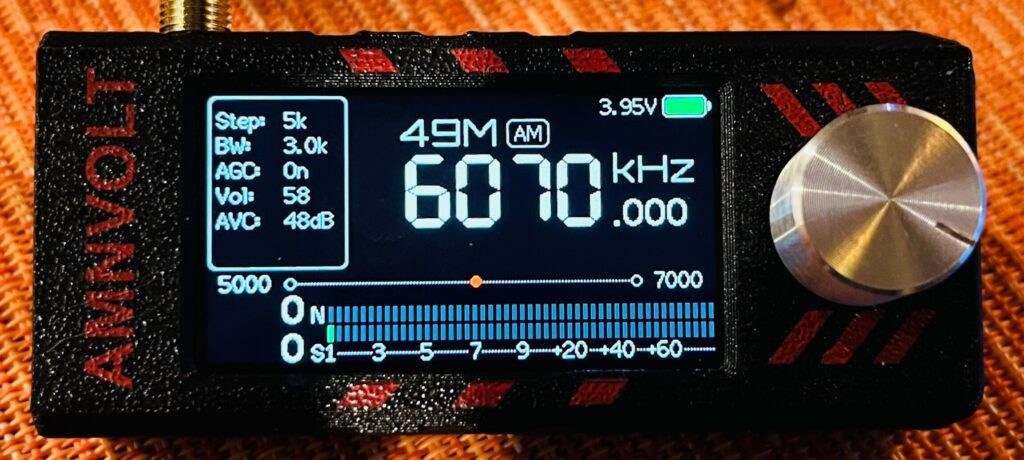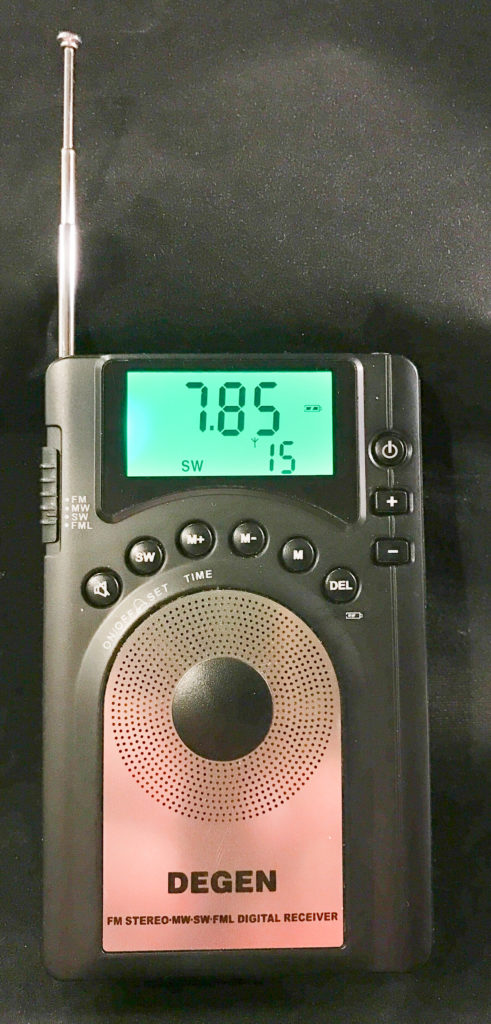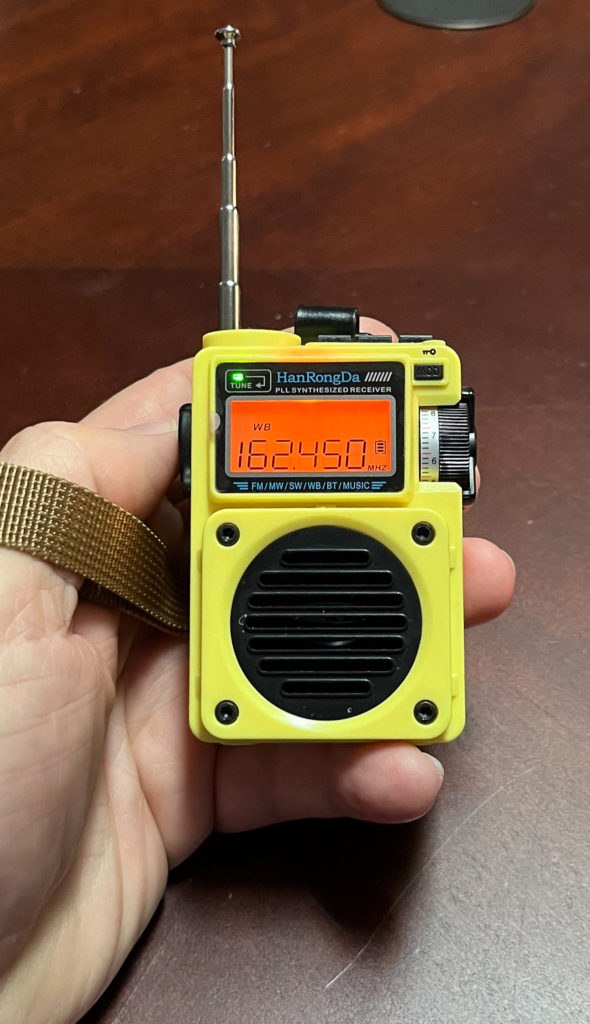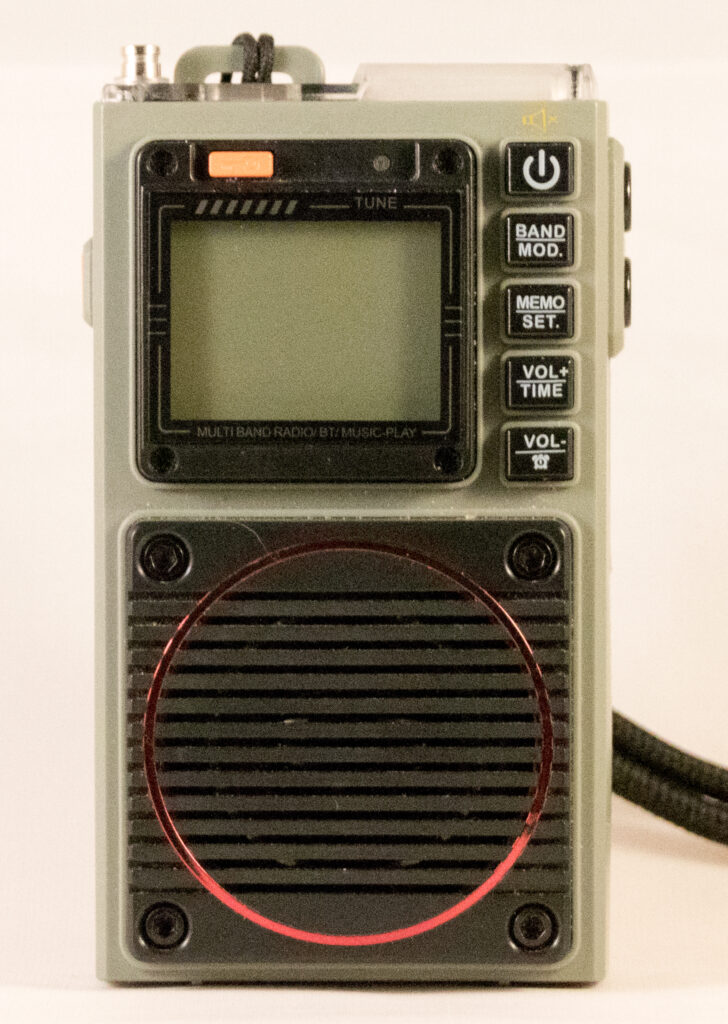Several small shortwave radios reside in my accumulation and I’m interested to see how they compare, especially how newer ones compare to older ones. At least a dozen of my radios fit the “Ultralight” category (volume under 20 cubic inches), including some serious radios like the Tecsun PL-330 and the Qodosen DX/SR-286. While those radios are small, I don’t consider them “little,” and little is more the concept I’m going for here. So here is a little list:
- Amnvolt ATS Mini (V3)
- Degen DE-15
- HanRongDa HRD-701
- Jazmm 213
- Raddy RF75A
- Raddy RF760
Amnvolt ATS Mini (V3)
The ATS radios have created massive interest because they are software defined, and open source firmware updateable. They come in various sizes and form factors, with the ATS Mini being the smallest, and their capabilities are rapidly evolving. It’s the smallest entry in this review, but packed with features, including SSB and FM RDS. It even connects to Wi-Fi and downloads shortwave schedules for display.
The radio has no antenna, and one must be provided, via the SMA connector. One could hook up a donut antenna, a dipole, a long wire, a telescopic antenna or an amplified loop like the MLA-30+.
Frequencies supported are LW, MW, SW and FM. The firmware as of this review is v2.27.
Tuning with the current firmware relies largely on selecting a meter band from the Band menu. From there the step can be set to rapidly tune through the band to reach a desired station. With a little practice, one can become proficient tuning it. There is an “ALL” band covering all of SW and this one is needed to reach some frequencies, like 15 MHz not included in any of the other bands.
Degen DE15
The Degen DE15 is the oldest radio in the group (from 2011) and still a favorite because of its compact size; it’s the thinnest of all, a mere 0.64″. It has a wonderful green display and a clock that is always on when the radio is turned off.
This radio, too, has the ability to select a meter band for international broadcast frequencies by repeatedly pressing the SW button. From there there is are tuning buttons that scan faster when held down.
The Degen DE15 was also sold under the Sunstech RP-DS30 branding.
HanRongDa HRD-701
The HanRongDa HRD-701 is another all-time favorite that I bring out every year for National Yellow Radio Day. It’s really clever in the way it packs many functions into so few buttons, and it has one of the most efficient ways of tuning of any radio. And the clock is always on.
It has an advanced tuning mode. When you turn the tuning knob, you will see a tiny caret symbol appear inside and near the top of the right-most digit. The tuning wheel increments on that digit. If you press the MOD button, the caret will shift one digit to the left and then the tuning wheel controls that digit. It’s a clever way to do near direct entry of a station frequency. This allows relatively fast tuning despite the lack a frequency entry keypad.
The HRD-701 is also sold as the Zhiwhis ZWS-701.
Jazmm 213
The Jazmm 213 is the newest radio in my collection. This article is my opportunity to exercise it on shortwave. It supports weather alerts and has a fantastic speaker.
Tuning is accomplished by a long press of the Tuning buttons on the side that initiates a scan for the next station, not a particularly sensitive scan it seems. Continuing to hold down the button results in a very fast increment/decrement of the frequency. This scan is independent of the automatic tune storage (ATS) initiated by the SCAN button.
The Jazmm 213 is also sold under the Degen 213 branding, as well as the Green Lion Voyager (Model 990478120969). The OEM manufacturer appears to be Zhuhai Meding branded as the Meding MD-213.
Raddy RF75A
The Raddy RF75A is the second smallest of the group. It also has a good speaker, weather alerts, AIR band and VHF coverage.
While the Raddy RF75A lacks a numeric keypad on the radio, there is a numeric keypad in the phone app tied to the radio with Bluetooth, where direct frequency entry is possible. A long press of one of the tuning buttons initiates a fast scan, and holding the button down increases the frequency even faster.
The Raddy RF75A is also sold under the HanRongDa HRD-787 alternate branding.
Raddy RF760
The RF760 is perhaps a more serious radio than the other little radios (excepting the ATS Mini). It is in a higher price range and covers the widest range of frequencies, from LW to UHF, Weather and even a user-defined band.
The RF760 implements the same digit-by-digit tuning method supported by the HRD-701. Turn the tuning knob briefly to display the caret symbol and then quickly press the STEP button to select the digit that increments when the tuning wheel is turned.
The RF760 is also sold as the HanRongDa HRD-747 and the Retekess TR-110.
Features
All of the selected radios use digital signal processing (DSP) and all of them have digital screens. None provides key-entry of frequencies.
Yes, it’s now time for the Blog or Die! signature big feature table.
| Feature | ATS Mini | DE-15 | HRD-701 | 213 | RF75A | RF760 |
|---|---|---|---|---|---|---|
| Weather | Y | Y | Y | Y | ||
| MP3 | Y | Y | Y | |||
| Bluetooth | Y | Y | Y | |||
| Flashlight | Y | Y | ||||
| SSB | Y | Y | ||||
| Belt Clip | Y | Y | ||||
| SW range (MHz) | 1.711 – 30 | 2.3 – 23 | 4.75 – 21.85 | 4.75 – 21.85 | 4.75 – 21.85 | 3.2-30 |
| Presets (SW) | 32 | 100 | 99 | 100 | 99 | 100 each for SW, USB and LSB |
| Wi-Fi | Y | |||||
| Battery | 800 mAh | 3 AAA | BL-5C | 1250 mAh | 1000 mAh | BL-5C |
| USB Charge | C | Mini | C | C | C | C |
| Speaker | 1W | 3W | 5W | 3W | 1W | |
| Mute | Y | Y | Y | Y | ||
| Clock | Note 2 | Y | Y | Y | Y | |
| Clock always visible | Y | Y | ||||
| Antenna | n/a | 10″ | 11″ | 11″ | 13″ | 21″ |
| Ext. antenna connector | Y | Note 1 | Y | |||
| Signal strength | Y | Y | Y | Y | ||
| Scan tuning | Y | Y | Y | Y | Y | Y |
| Amazon price | $47.99 | $38 (2011) | $34.99 | $23.75 | $42.99 | $68.99 |
Shortwave performance testing
Because of the wide disparity in antennas (with one radio not even having an antenna), and because most of the other radios have very short antennas, anyone seriously trying to use one of these for shortwave is going to us an external antenna. I’m using either a Sangean ANT-60, 7 meters long or the 20-foot wire diagonally up a tree (WUT).
Behind the scenes, I’ll be using the Qodosen DX-286 to find the stations I’m testing. It has a fantastic scan ability.
Trial 1: On the Patio
The first test was around 2pm in the afternoon (18:00 UTC). Normally at that time of day, I’ll get US stations like WRMI, the US and Canadian time stations, and a weak signal from CFRX in Toronto.
There was hardly anything to listen to, even WWV was absent, and certainly no CFRX. The ATS Mini was the worst of the bunch, barely getting anything that the rest of the radios did. Who knew? I tried the telescopic, the red d0nut, the black donut and the 20-foot WUT clipped on.
Someone on Facebook suggested checking the AGC and RF gain setting. One can see from the photo at the top of the article that I had AGC ON and RF gain (AVO) set at the default value of 48. Latter that night I was getting more hooked up to the MLA-30+ loop antenna, but clearly, I have a noise problem
Trial 2: At the Pond
I drove down to the pond just before 8 AM local time. That’s where the photo at the top of the article came from. I also took the DX-286 with me to quickly locate stations, and right away there was a very nice signal from CFRX in Toronto, one apparently that was to decline fairly quickly.
Here is some video from that first attempt. In what follows the little radios had a 23-foot Sangean ANT-60 clipped on. In the cameo from the DX-286, it’s using the telescopic. The table was tilted and so most of the radios were propped up next to the coffee cup I brought along for scale to prevent them falling over.
Next I tried a stronger station, a religious broadcast on 9395 from WRMI.
The third station on 13,810 is I think a broadcast from Korea:
Finally a broadcast on 12050 kHz, I think from EWTN in the US.
Summary
As far as reception goes, it seems like the ATS Mini is a toy, a very sophisticated toy, but nevertheless a toy. Maybe I have a bad unit, or a bad firmware release, or an mismatched antenna — I don’t know, but this radio simply doesn’t perform on shortwave. Features abound, but not performance. At some point I may compare my V1 mini with the V3 mini and see if there’s a difference. [Update: later testing gave better results. See: V1 v V3 v PL-330: ATS Mini Sensitivity. I suspect that the low power speaker in the ATS Mini might have made the difference.]
The real surprise was now good the Jazmm 213 is. The speaker is tremendous and reception is no slouch either. I’ll call out two other radios for outstanding speakers, the RF75A and the HRD-701. I made a separate video some time ago highlighting the HRD-701 speaker:
And another that shows off the RF75A.
I’ve always liked the Degen DE15 and it proved to be a good performer in these texts. It shows the clock on the screen when the radio is on, a benefit for making videos (assuming the clock is set).
The RF760 did a credible job, but it has a tinny speaker and it was not outstanding for reception.
Postscript
I mention here briefly the ultralight radios that were not included. The links below are to other articles mentioning them.
- Qodosen DX/SR-286. This radio is totally excellent and is my daily driver. It’s had good coverage here on the blog already. It’s in a class beyond the little radios selected here.
- Sihuadon R-108. It’s roughly the same size as the DX-286, and probably belongs in a different class than these little ones.
- Tecsun PL-330. Another serious radio to which these “little radios” are not comparable.
- Degen DE1131. This one was on the list at first, but I just don’t like it much and it’s not interesting.
- Zhiwhis ZWS-603. Another one from the initial list, the Zhiwhis was dropped to help make the list size manageable and because unlike all the rest, it has direct frequency entry.
- Kaide KK-MP903. This was dropped from the list simply because it’s an older model, no longer available, and so of lesser interest.
- Kaito WRX911. I’m only including digital radios with digital display.
- Kait0 KA29. It pushes the size limit, and again is no longer in production.
- Prunus J-429SW. It also pushes the size limit and is not especially interesting.
- Mesqool CR1015. Not many of these were sold before they came up with a new model. It’s a pain to tune. Technically, it fits my criteria, but I’m not interested.







